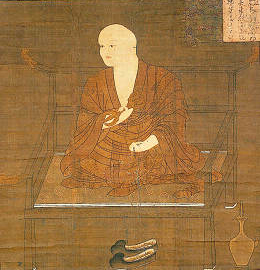
Kūkai (空海) is a famous historical figure in Japan.
He founded the Shingon School of Buddhism (真言宗) and along with a fellow monk named Saichō, brought tea seeds to Japan from China.
These are just some of the many achievements of Kūkai, as we’ll see next.
The story of Grand Master Kūkai
Kūkai was born in the year 774, present day Kagawa prefecture. His birth name was Mao (真魚).
He came from a wealthy family, so that at eighteen he went to the capital to study at the government university.
Few people in his time had this privilege. Once he graduated he could become a government official.
Although he was an excellent student, he wasn’t satisfied with the university. He came in contact with Buddhism and decided to take that path instead.
Thus Kūkai began his ascetic practice. By age 24 he had published the Sangō Shiiki (三教指帰), which is a series of three volumes that basically compares Taoism, Confucianism, and Buddhism.
He was an independent monk for many years and studied all the Buddhist texts that he could get his hands on. At that time he was very competent in classical Chinese prose and calligraphy.
Through his studies he came into contact with the Mahavairocana Tantra which had recently been brought from overseas.
He found it difficult to understand. Especially because some parts where written in Sanskrit in the Siddhaṃ script. Actually, there was no one in Japan that could fully explain this teachings to him.
It was then when he sought to travel to China and expand his knowledge of Buddhism.
He would have his chance in 804, when he was 30 years old.
He joined an expedition to China backed by the government. It’s not clear why he was allowed to take part in it. Probably his family’s connections played a role.
The monk Saichō was a prominent member of the envoy. He was already famous and backed by the emperor himself. In contrast, Kūkai was just an unknown monk.
Once in China, Kūkai had the fortune to meet Master Huiguo (惠果) a year later. Huiguo taught him Tantric Buddhism.
Amazingly, Kūkai mastered his teachings in just a few months, becoming a master of the Tantric lineage.
Huiguo knew that his time would soon come to an end. Shortly before his death in 805, he urged Kūkai to return to Japan in order to impart his teachings to others.
As fate would have it, Huiguo’s lineage would not survive as an independent school in China.
Kūkai was supposed to stay in China for 20 years. However, he had the opportunity to return to Japan after just two years.
While in China, he also studied civil engineering, pharmacy, calligraphy and poetry.
When Kūkai came back, written records show that he brought with him many texts, and also tea seeds and a stone mill. He gave the tea to Emperor Saga as an offering.
In 812, Saichō started to learn Tantric Buddhism from Kūkai. Their friendship lasted many years, but it started to deteriorate and in the end each took a different path.
In 821 Kūkai used his expertise in civil engineering in order to restore Manno Reservoir, which is Japan’s largest irrigation dam.
Previous restorations attemps had been failed, but thanks to the new technology at the time Kūkai succeeded. This brought him much fame.
Emperor Saga supported Kūkai. In 823 he granted him East Temple (東寺) in Kyoto, so that at age 49 Kūkai established the Shingon School of Buddhism (真言宗).
It would be too lengthy to list the many achievements of Kūkai. But among them are being included as one of the Sanpitsu (三筆, three brushes). Which means that along with Emperor Saga, he was one of the three great calligraphers of the Heian period.
In 828, he founded the first public school of Japan, the Shugei shuchi-in (綜芸種智院). Social rank was not a barrier to entry (something previously unheard of), and the students received free meals.
Because of Kūkai’s genius and generosity, many anecdotes and legends about him are still alive.
He passed away in 835, when he was 62 years old.
Sources:
https://ja.wikipedia.org/wiki/%E7%A9%BA%E6%B5%B7
